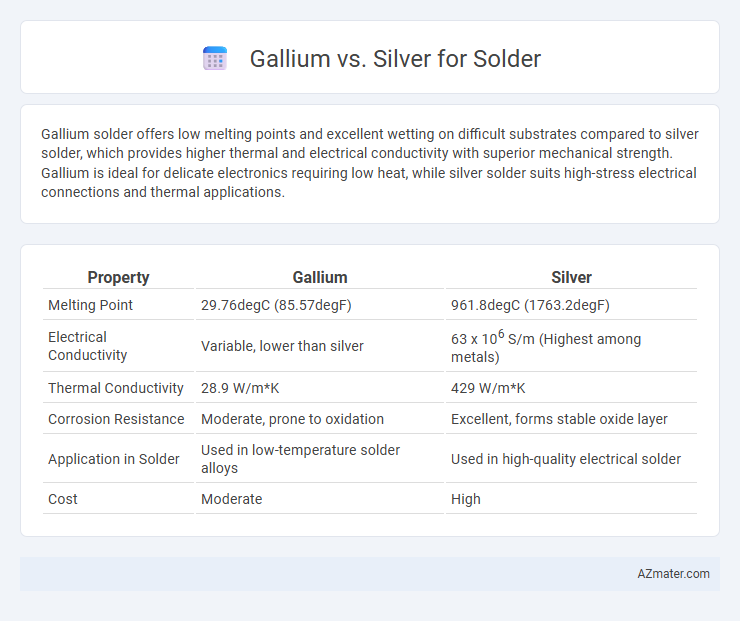Gallium solder offers low melting points and excellent wetting on difficult substrates compared to silver solder, which provides higher thermal and electrical conductivity with superior mechanical strength. Gallium is ideal for delicate electronics requiring low heat, while silver solder suits high-stress electrical connections and thermal applications.
Table of Comparison
| Property | Gallium | Silver |
|---|---|---|
| Melting Point | 29.76degC (85.57degF) | 961.8degC (1763.2degF) |
| Electrical Conductivity | Variable, lower than silver | 63 x 106 S/m (Highest among metals) |
| Thermal Conductivity | 28.9 W/m*K | 429 W/m*K |
| Corrosion Resistance | Moderate, prone to oxidation | Excellent, forms stable oxide layer |
| Application in Solder | Used in low-temperature solder alloys | Used in high-quality electrical solder |
| Cost | Moderate | High |
Introduction to Gallium and Silver in Soldering
Gallium, a soft, low-melting metal with a melting point of about 29.76degC, offers excellent wetting properties and low toxicity compared to traditional solder materials. Silver, known for its superior electrical conductivity and thermal performance, is commonly added to solder alloys to enhance mechanical strength and corrosion resistance. Both metals play crucial roles in soldering, where gallium-based solders provide flexibility in low-temperature applications, while silver-containing solders ensure durability and high-performance connections.
Chemical Properties and Reactivity Comparison
Gallium exhibits a low melting point of about 29.76degC and forms strong alloys with many metals, making it highly reactive in soldering applications compared to silver, which has a much higher melting point of 961.8degC and greater chemical stability. Gallium's ability to wet and infiltrate metal surfaces distinguishes it from silver, whose lower reactivity results in less aggressive bonding and corrosion resistance. Silver's superior electrical conductivity contrasts with gallium's chemical reactivity, influencing their effectiveness in different solder compositions and electronic applications.
Melting Points and Working Temperatures
Gallium has a melting point of about 29.76degC, allowing it to liquefy near room temperature, while silver's melting point is significantly higher at 961.8degC, making it suitable for high-temperature soldering applications. Gallium-based solders operate effectively at lower working temperatures, reducing thermal stress on components, whereas silver-based solders require elevated temperatures that enhance mechanical strength and conductivity. The choice between gallium and silver solder depends on the desired balance between melting point, working temperature, and application-specific thermal requirements.
Electrical Conductivity: Gallium vs Silver
Silver exhibits significantly higher electrical conductivity than gallium, with silver's conductivity measured at approximately 6.30 x 10^7 S/m compared to gallium's much lower value near 2.7 x 10^6 S/m. This superior conductivity makes silver a preferred choice for solder in high-performance electrical and electronic applications where minimal resistance and efficient current flow are critical. Although gallium offers unique properties such as low melting point and flexibility, its relatively poor electrical conductivity limits its effectiveness in applications requiring optimal electrical performance.
Wetting Behavior and Joint Reliability
Gallium solder exhibits superior wetting behavior on diverse substrates compared to traditional silver solder, forming more uniform and thinner intermetallic layers that enhance mechanical bonding. Gallium's low melting point promotes reduced thermal stress during soldering, improving joint reliability by minimizing microcracks and thermal fatigue under cyclic loading. Silver solder joints, while offering higher melting temperatures suited for high-power applications, often face challenges in consistent wetting and increased brittleness at the interfaces, potentially compromising long-term joint integrity.
Corrosion Resistance and Long-Term Durability
Gallium-based solders exhibit superior corrosion resistance compared to silver-based solders, due to gallium's ability to form stable oxide layers that protect joints from environmental degradation. Silver solders, while offering high thermal and electrical conductivity, are more prone to tarnishing and galvanic corrosion in humid or corrosive environments, which can compromise long-term reliability. For applications requiring enhanced durability and minimal maintenance, gallium alloys provide a more robust solution in resisting oxidation and ensuring extended joint lifespan.
Compatibility with Substrates and Components
Gallium-based solders offer superior compatibility with substrates like aluminum and certain plastics due to their low melting points and minimal thermal stress, reducing the risk of component damage. Silver solder excels in bonding with traditional metals such as copper and nickel, providing strong mechanical and electrical connections but often requires higher temperatures that can affect sensitive components. Selecting between gallium and silver solder depends on the substrate material and component heat tolerance, optimizing joint integrity and long-term reliability.
Cost Efficiency and Material Availability
Gallium's cost efficiency for soldering is limited due to its higher market price and lower availability compared to silver, which is more abundant and economically accessible in industrial quantities. Silver-based solders benefit from established supply chains and lower raw material costs, making them preferable for large-scale manufacturing. Despite silver's availability advantage, gallium offers unique properties such as low melting points, but these benefits often do not outweigh the higher material costs and limited sourcing options.
Environmental and Safety Considerations
Gallium is non-toxic and poses minimal environmental hazards, making it a safer alternative to silver in solder applications, which can release harmful silver ions and compounds during manufacturing and disposal. Unlike silver, which is a heavy metal with potential bioaccumulation risks, gallium's lower environmental impact aligns with sustainable electronics manufacturing practices. Gallium solder alloys also exhibit lower skin sensitization and reduce exposure to toxic fumes compared to silver-based solder, enhancing workplace safety.
Best Use Cases for Gallium and Silver Solders
Gallium solder excels in low-temperature applications, ideal for delicate electronics and heat-sensitive components due to its melting point around 29.8degC, which prevents thermal damage during assembly. Silver solder, with a higher melting point above 600degC, is preferred for high-strength joints in plumbing, aerospace, and electrical connections where durability and conductivity are critical. Using gallium enables flexible electronics manufacturing, while silver solder offers superior mechanical performance for heavy-duty and high-temperature environments.

Infographic: Gallium vs Silver for Solder
 azmater.com
azmater.com